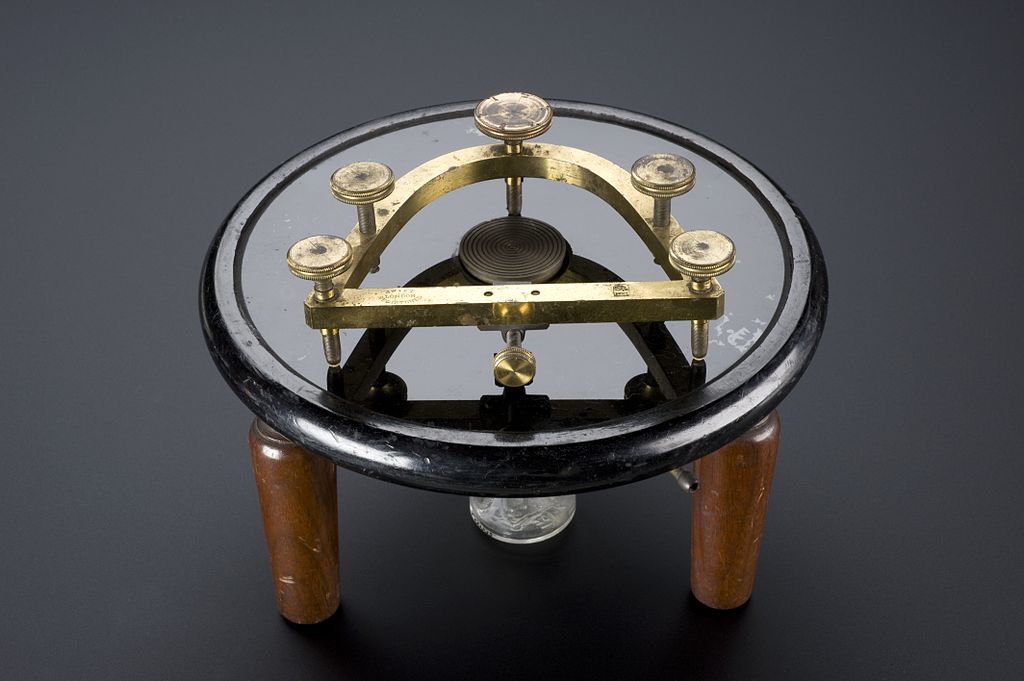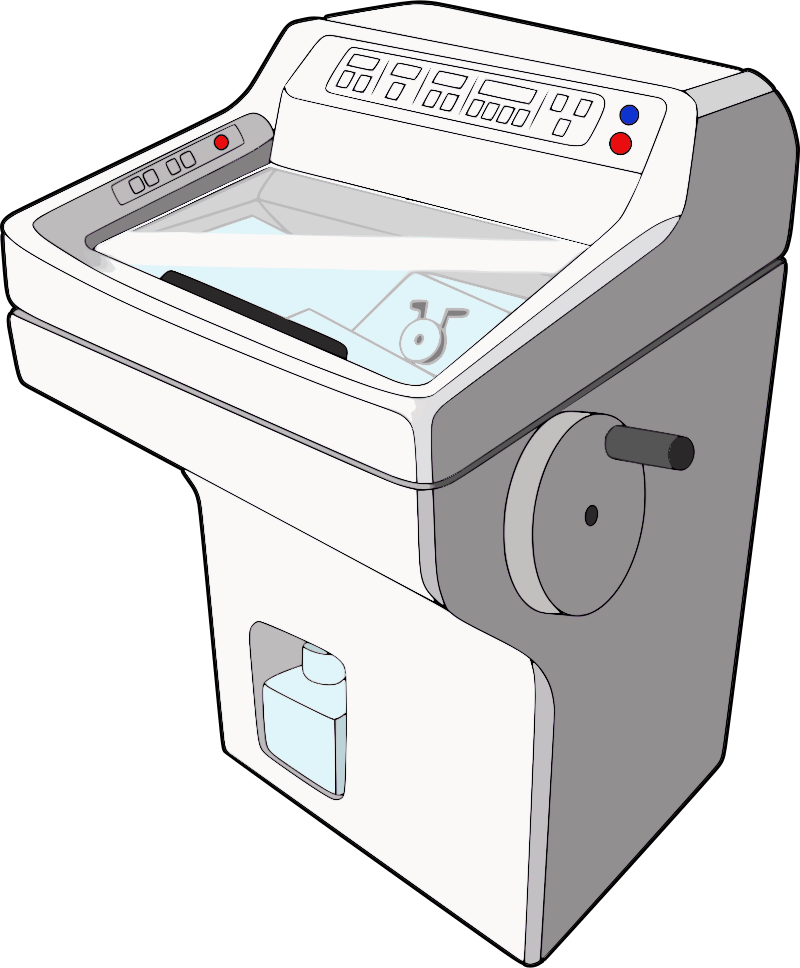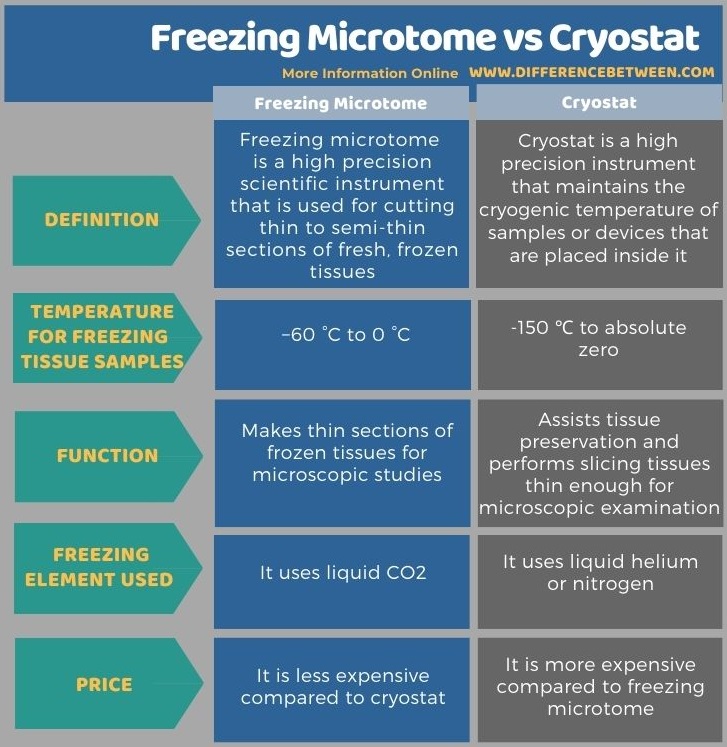Difference Between Freezing Microtome and Cryostat
The key difference between freezing microtome and cryostat is that freezing microtome is an instrument using for making thin sections of frozen tissues for microscopic studies, while cryostat is an instrument that maintains the cryogenic temperature of samples or devices that are placed inside it.
Human tissue specimens are used by biomedical researchers in various areas of clinical research. Frozen tissues are analysed through histological studies in pathology. Frozen tissues work very well for molecular genetic analysis. Moreover, they are very easy to prepare. They are also very useful for IHC analysis. Therefore, the preparation and maintenance of frozen tissues for different analysis are extremely important. Freezing microtome and cryostat are two instruments used for the preparation and maintenance of frozen tissues.
CONTENTS
1. Overview and Key Difference
2. What is Freezing Microtome
3. What is Cryostat
4. Similarities Between Freezing Microtome and Cryostat
5. Side by Side Comparison – Freezing Microtome vs Cryostat in Tabular Form
6. Summary
What is Freezing Microtome?
Freezing microtome is a high precision scientific instrument used for cutting thin to semi-thin sections of fresh, frozen tissues. This instrument is also used for slicing semi-thin sections of industrial products such as textiles, paper, leather, soft plastics, rubber, powders, pastes, and food products. For the above purpose, the instrument uses a CO2 freezing attachment.

Figure 01: Freezing Microtome (older version)
The freezing microtome is equipped with a stage upon which tissues can be quickly fixed. Once the tissue is fixed, it is frozen using either liquid carbon dioxide from a cylinder or a low-temperature re-circulating coolant. The water-rich tissues are first hardened by freezing. Then frozen state tissues are cut with a microtome. Ultimately, these thin sections can be stained and observed through a light microscope. This method is much faster than the traditional histology technique. It is used in conjunction with other medical procedures to achieve a quick diagnosis. The frozen sections cut by freezing microtome can also be used in immunohistochemistry (IHC) as freezing a tissue stops the degradation of tissue faster than using a fixative. Furthermore, the freezing microtome does not alter or mask the chemical composition of the tissue, which is very useful for biological analysis.
What is Cryostat?
A cryostat is a high precision machine that maintains the cryogenic temperature of samples or devices that are placed inside it. It is also known as a Dewar flask. Cryostats are useful in medicine, science, and engineering to assist tissue preservation and to perform slicing tissues thin enough for microscopic examination. A cryostat possesses five parts, including a freezing shelf, specimen holders, microtome, blade holder, and anti-roll guides.

Figure 02: Cryostat
Cryogenic temperatures that are maintained by cryostat is about the range of -150℃ to absolute zero. In these temperatures, the molecular motion of tissues comes as close as possible. The low temperatures are achieved by using either liquid helium or nitrogen. It is used to study the margin of cancers, quick diagnosis of tissue sections, examine enzyme histochemistry to diagnose and treat neuromuscular diseases, histopathology and immunohistology.
What are the Similarities Between Freezing Microtome and Cryostat?
- Freezing microtome and cryostat are two instruments that process frozen tissue samples.
- Both instruments have microtome to section the tissues.
- They are used in pathology laboratories.
- Both instruments provide quick diagnosis of tissue sections and provide fast results.
What is the Difference Between Freezing Microtome and Cryostat?
A freezing microtome is an instrument used to make thin sections of frozen tissues for microscopic studies. On the other hand, a cryostat is an instrument that maintains the cryogenic temperature of samples or devices that are placed inside it. So, this is the key difference between freezing microtome and cryostat. Moreover, the freezing microtome uses temperature within a range from −60 °C to 0 °C for freezing the tissue samples. Meanwhile, cryostat uses temperature within a range from -150 ℃ to absolute zero for freezing the tissue samples. Thus, this is another difference between freezing microtome and cryostat.
Below is a summary of the difference between freezing microtome and cryostat in tabular form.

Summary – Freezing Microtome vs Cryostat
The frozen section of tissue is the rapid tissue section prepared by cooling the tissue with the help of a freezing element to provide an immediate report of the tissue sample. These tissue sections are often used in pathology laboratories. Freezing microtome and cryostat are two instruments that use for the preparation and maintenance of frozen tissues. The freezing microtome makes thin sections of frozen tissues while the cryostat maintains the cryogenic temperature of samples or devices that are placed inside it. Thus, this is the key difference between freezing microtome and cryostat.
Reference:
1. “Freezing Microtome (Erma Type).” Hover Labs- Educational Scientific Equipments Manufacturers, Available here.
2. “Definition of Cryostat.” MedicineNet, MedicineNet, 29 Mar. 2021, Available here.
Image Courtesy:
1. “Freezing microtome, London, England, 1883-1885 Wellcome L0058209” By Welcome Image Gallery (CC BY 4.0) via Commons Wikimedia
2. “201804 Cryostat” By DataBase Center for Life Science (DBCLS) – (CC BY 4.0) via Commons Wikimedia
ncG1vNJzZmivp6x7pbXFn5yrnZ6YsqOx07CcnqZemLyue8OinZ%2Bdopq7pLGMm5ytr5Wau26y0Z6cs6GenHqutcKrpq2nnZp6orrDZpqrsZ%2BowaLAjg%3D%3D